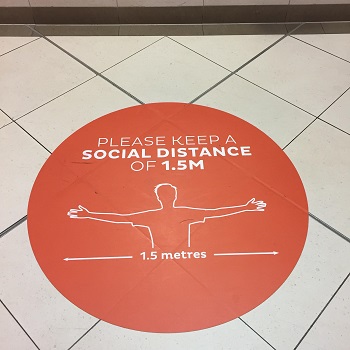
SOCIAL DISTANCING CONSIDERATIONS IN A PANDEMIC WORLDBy Kim Pilic
What are the social distancing considerations and implications for people who experience blindness and low vision, in public spaces? Australians are being encouraged to engage in measures and behavioural practices designed to address the current COVID-19 pandemic. The key interventions to mitigating and abating this situation include good hygiene practices; reduced public gatherings; self-isolation; and, social distancing. Unfortunately for people who experience blindness and low vision, the concept and practice of social distancing imposes conflicting functional implications in public spaces and places. Imagine not being able to engage human guide technique in public, because it requires physical contact with another person; or, being confronted with the public who are providing inadequate and unadjusted spaces to accommodate for social distancing, when walking past them. It can be said that social distancing causes a quandary, subsequently raising a serious question for individuals who experience blindness and low vision: Question: “When using a white cane or dog guide, how does one negotiate social environments with complete certainty of being 1.5 meters apart from another person”? Factors that generate a degree of uncertainty around social distancing in social spaces include: inability to see others’ physical positioning; visual inability to interpret surrounding activities; unfavourable lighting conditions reducing visual functionality; publics’ dynamic movements being a challenge to track; public moving unpredictably, erratically and ununiformly; unknown obstacles appearing out of seemingly nowhere; known environments having changed; spatial orientation being affected; depth perception being challenged; and, one of the biggest factors, people generally not moving out of the way. Under ordinary circumstances, the long cane and dog guide traveller would move from point A to point B in any given environment, within socially acceptable spaces, of less than 1.5 meters. In contrast, these travellers are now subject to the mercy, lateral and forward-thinking actions of the public, centred on empathetic and literally measured practicalities around creating sufficient space to pass through. One would hope that public decency and common sense would be applied, even if they possess insufficient knowledge about white canes and working dogs. Afterall, these two primary mobility aids are communication symbols designed to inform the public to look out for them – pay attention, move out of the way, and extend verbal assistance if necessary, (of course, from a distance with current social practices). In proactive response to social distancing concerns, I have seen an effective catchphrase circulating to educate the public. It reads, “Guide Dogs don’t understand social distancing please move away 2 meters to help keep us all safe”. A very concise, powerful and educational message. I also spoke with a friend, Jess, this morning, who has a retired dog guide. She commented on having navigated very narrow social spaces, including occasions of walking right between people who were having face to face conversations. (Now that gets the mind’s eye visualising – I can just see it unfolding now)! Anyway, this scenario would not be considered socially impolite, as her dog was problem solving and applying initiative in reaching a set objective. However, if this scenario occurred in today’s social distancing climate, one would hope that whoever is having a distanced face to face conversation with each other would courteously move aside, so as to create a larger space for negotiation. People who experience blindness and low vision do their utmost to navigate independently, with physical safety being paramount. The public can play an enormous part in ensuring this continues, in addition to considering their health and wellbeing as being paramount. The public are encouraged to apply necessary social distancing measures, so as to create larger, more accessible spaces, as a behavioural practice. Proper social distancing is in the hands of the community at large. And, for those who do not experience blindness or low vision, please be remindful and thoughtful in considering those who do.

 Follow us on Facebook
Follow us on Facebook